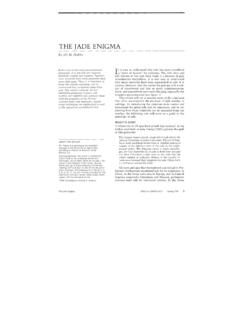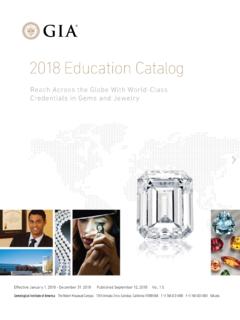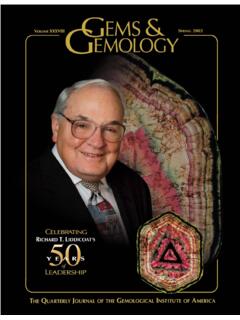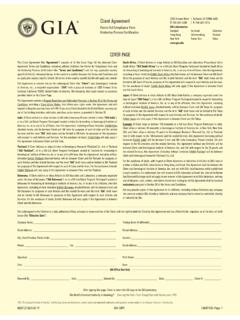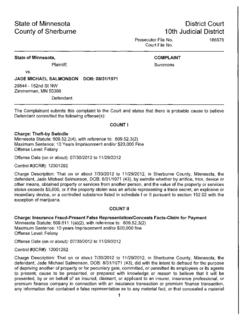Transcription of Burmese Jade: The Inscrutable Gem - gia.edu
1 Burmese jade : THE Inscrutable GEM. By Richard W. Hughes, Olivier Galibert, George Bosshart, Fred Ward, Thet Oo, Mark Smith, Tay Thye Sun, and George E. Harlow The jadeite mines of Upper Burma (now Myanmar) occupy a privileged place in the If jade is discarded and pearls destroyed, petty thieves world of gems, as they are the principal source of top-grade material. This article, by the first will disappear, there being no valuables left to steal. From a dictionary published during the reign of foreign gemologists allowed into these impor- Emperor K'ang Hsi (1662 1722 AD) , as quoted by Gump, 1962. tant mines in over 30 years, discusses the his- P.
2 Tory, location, and geology of the Myanmar jadeite deposits, and especially current mining erhaps no other gemstone has the same aura of mys- activities in the Hpakan region. Also detailed tery as Burmese jadeite. The mines' remote jungle are the cutting, grading, and trading of jadeite in both Myanmar and China as location, which has been off-limits to foreigners for well as treatments. The intent is to remove decades, is certainly a factor. Because of the monsoon rains, some of the mystery surrounding the Orient's this area is essentially cut off from the rest of the world for most valued gem. several months of the year, and guerrilla activities have plagued the region since 1949 (Lintner, 1994).
3 But of equal importance is that jade connoisseurship is almost strictly a Chinese phenomenon. People of the Orient have developed jade appreciation to a degree found nowhere else in the world, but this knowledge is largely locked away ABOUT THE AUTHORS in non-Roman-alphabet texts that are inaccessible to most Mr. Hughes Westerners, adding further to jadeite's Inscrutable reputa- is an author, gemologist, and webmaster at tion. The mines of Burma (now Myanmar ) are the primary Pala International, Fallbrook, California. Mr. working deposits for the most prized gem in the Far East Galibert (FGA, hons.; ING, AG) is a gemolo- gist and Hong Kong based dealer in colored (figure 1), a stone exceeded in price only by diamond.
4 Stones and pearls. Mr. Bosshart is chief This article will draw back the curtain on this enigmatic gemologist, Research and Development, at gem, revealing the manner in which Burmese jadeite is the G belin Gem Lab, Lucerne, Switzerland. Mr. Ward, a gemologist, writer, and photog- mined, traded, graded, cut, treated, and faked. Since the rapher, owns Gem Book Publishing, major gemological features of jade have already been exten- Bethesda, Maryland. Dr. Thet Oo is a gemol- sively covered in the literature (Hobbs, 1982; Fritsch et al., ogist and Yangon-based dealer in colored stones. Mr. Smith is a gemologist and 1992; Wang, 1994), emphasis here will be on these lesser- Bangkok-based dealer in colored stones.
5 Known aspects. An understanding of jadeite is not limited to Dr. Tay is president of Elvin Gems and Far the technical or exacting, but it also requires a feeling for the Eastern Gemmological Lab of Singapore. Dr. Harlow is curator of Gems and Minerals cultural, textural, and ephemeral qualities that make the at the American Museum of Natural History, study of jade unlike any other in the world of gemstones. New York City. jade has a rich history in the Orient, especially China Please see acknowledgments at the end of (Box A). Historically, the term jade was applied to any of a the article. number of ornamental materials that could be carved, but Gems & Gemology, Vol.
6 36, No. 1, pp. 2 26 most importantly amphibole jade , or nephrite. The rich 2000 Richard W. Hughes green material subsequently found in Myanmar proved to be composed primarily of a different mineral (a pyroxene) and 2 Burmese jade GEMS & GEMOLOGY Spring 2000. Figure 1. Windows cut into this otherwise undis- tinguished boulder from the Myanmar jade Tract reveal the presence of a rich green in the jadeite beneath the skin. Boulders such as this are the source of the fine green, orange- red, and lavender cabo- chons that are much sought-after in China and elsewhere. The bowl is approximately 6 cm wide 5 cm high. The cabo- chons measure approxi- mately 15 19 mm (green), 13 18 mm (orange-red), and 10 14.
7 Mm (lavender). Courtesy of Bill Larson and Pala International; photo . Harold & Erica Van Pelt. was named jadeite (see Box B). In this article, jade One European known to have traveled in the general encompasses both jadeite and nephrite in those area was Swedish journalist Bertil Lintner, who in instances where the general carving material is 1985 86 made an epic journey through rebel-held being referenced, but jadeite or jadeite jade will be areas of northern Myanmar, including the region used to refer to the rock that is predominantly surrounding Hpakan (see, , Lintner, 1996). But he jadeite, where appropriate. was unable to visit the mines themselves.
8 Although jadeite deposits are found throughout On February 24, 1994, a formal cease-fire was the world (Guatemala, Japan, Russia, and California), signed between the Myanmar government and the Myanmar remains the primary source of top-grade main rebel group, the Kachin Independence Army material. The Hpakan jadeite region (figure 2) is one (Lintner, 1996). In June 1996, RWH, OG, MS, and of the wildest, least-developed areas of the country. TO made a brief trip to Hpakan. To give some idea Until the authors' first trip, in 1996, no foreign of the sensitivity of this area, months were needed gemologists had visited the mines since Edward to obtain permission, with final approval coming G belin in 1963 (G belin, 1964 65, 1965a and b).
9 From the second-highest-ranking general in the rul- ing SLORC (State Law and Order Restoration Committee) military junta. RWH again visited the *In the local vernacular, the country has always been called mines in March 1997, this time accompanied by Myanmar. The English name was officially changed to FW and a German film crew led by Bangkok-based Myanmar in 1988. Although many people continue to refer to it as Burma, in this article, the country will be referred to by its journalist Georg Muller. This trip included a visit to official name Myanmar. Tawmaw. In November 1997, GB and TO paid a Burmese jade GEMS & GEMOLOGY Spring 2000 3.
10 BOX A: jade HEAVEN'S STONE. More than 2,500 years ago, Gautama Buddha recog- weapons, and ornaments (Hansford, 1950). jade 's nized that much of life involves pain and suffering. antiquity contributes an aura of eternity to this gem. Consequently, few of us here on Earth have been Confucius praised jade as a symbol of righteousness provided with a glimpse of heaven. Instead, we and knowledge. mostly dwell in hell. But for the Chinese, there is a Yu ( I ), the Chinese word for jade , is one of the terrestrial bridge between heaven and hell jade . oldest in the Chinese language; its pictograph is said While gems such as diamond entered Chinese to have originated in 2950 BC, when the transition culture relatively recently, the history of jade (at the from knotted cords to written signs supposedly time, nephrite or another translucent material used occurred.)
